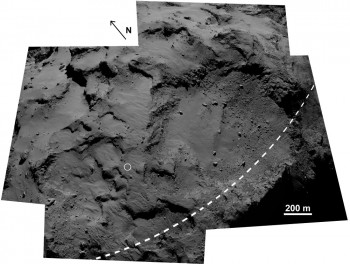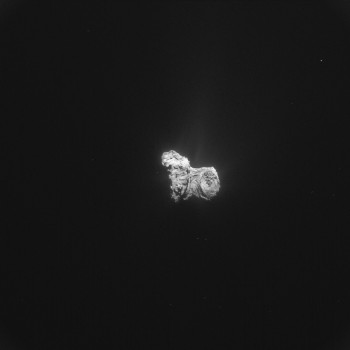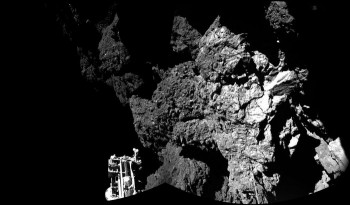One year since Philae made its historic landing on a comet, mission teams remain hopeful for renewed contact with the lander, while also looking ahead to next year’s grand finale: making a controlled impact of the Rosetta orbiter on the comet. This article is mirrored from the main ESA web portal.
Rosetta arrived at Comet 67P/Churyumov–Gerasimenko on 6 August 2014, and after an initial survey and selection of a landing site, Philae was delivered to the surface on 12 November.
After touching down in the Agilkia region as planned, Philae did not secure itself to the comet, and it bounced to a new location in Abydos. Its flight across the surface is depicted in a new animation, using data collected by Rosetta and Philae to reconstruct the lander’s rotation and attitude (Ed’s note: more details on the animation to follow in a dedicated blog post)
In the year since landing, a thorough analysis has also now been performed on why Philae bounced.
There were three methods to secure it after landing: ice screws, harpoons and a small thruster. The ice screws were designed with relatively soft material in mind, but Agilkia turned out to be very hard and they did not penetrate the surface.
The harpoons were capable of working in both softer and harder material. They were supposed to fire on contact and lock Philae to the surface, while a thruster on top of the lander was meant to push it down to counteract the recoil from the harpoon.
Attempts to arm the thruster the night before failed: it is thought that a seal did not open, although a sensor failure cannot be excluded.
Then, on landing, the harpoons themselves did not fire. “It seems that the problem was either with the four ‘bridge wires’ taking current to ignite the explosive that triggers the harpoons, or the explosive itself, which may have degraded over time,” explains Stephan Ulamec, Philae lander manager at the DLR German Aerospace Center.
“In any case, if we can regain contact with Philae, we might consider an attempt to retry the firing.”
The reason is scientific: the harpoons contain sensors that could measure the temperature below the surface.

The Agilkia area on comet 67P/Churyumov-Gerasimenko. The circle indicates where Philae touched down for the first time on 12 November 2014. The dashed line marks the comet’s equator. The large depression is the Hatmehit region. This image is a composite of five frames from the OSIRIS Narrow Angle Camera. Credits: ESA/Rosetta/MPS for OSIRIS Team MPS/UPD/LAM/IAA/SSO/INTA/UPM/DASP/IDA
Despite the unplanned bouncing, Philae completed 80% of its planned first science sequence before falling into hibernation in the early hours of 15 November when the primary battery was exhausted. There was not enough sunlight in Philae’s final location at Abydos to charge the secondary batteries and continue science measurements.
The hope was that as the comet moved nearer to the Sun, heading towards closest approach in August, there would be enough energy to reactivate Philae. Indeed, contact was made with the lander on 13 June but only eight intermittent contacts were made up to 9 July.
The problem was that the increasing sunlight also led to increased activity on the comet, forcing Rosetta to retreat to several hundred kilometres for safety, well out of range with Philae.
However, over the past few weeks, with the comet’s activity now subsiding, Rosetta has started to approach again. This week it reached 200 km, the limit for making good contact with Philae, and today it dips to within 170 km.
In the meantime, the lander teams have continued their analysis of the data returned during the contacts in June and July, hoping to understand the status of Philae when it first woke up from hibernation.
“We had already determined that one of Philae’s two receivers and one of the two transmitters were likely no longer working,” says Koen Geurts, Philae’s technical manager at DLR’s Lander Control Centre in Cologne, Germany, “and it now seems that the other transmitter is suffering problems. Sometimes it did not switch on as expected, or it switched off too early, meaning that we likely missed possible contacts.”
The team is taking this new information into account to determine the most promising strategy to regain regular contact.
But it’s a race against time: with the comet now heading out beyond the orbit of Mars, temperatures are falling.
“We think we have until the end of January before the lander’s internal temperature gets too cold to operate: it cannot work below –51ºC,” adds Koen.

Single frame enhanced NAVCAM image of Comet 67P/C-G taken on 31 October 2015. Credits: ESA/Rosetta/NAVCAM – CC BY-SA IGO 3.0
Meanwhile, Rosetta continues to return unique data with its suite of instruments, analysing changes to the comet’s surface, atmosphere and plasma environment in incredible detail.
“We recently celebrated our first year at the comet and we are looking forward to the scientific discoveries the next year will bring,” says Matt Taylor, ESA’s Rosetta project scientist.
“Next year, we plan to do another far excursion, this time through the comet’s tail and out to 2000 km. To complement that, we hope to make some very close flybys towards the end of the mission, as we prepare to put the orbiter down on the comet.”
The plan is to end the mission with a ‘controlled impact’ of Rosetta on the surface. This idea emerged around six months ago, when an extension of operations from December 2015 to September 2016 was announced.
The solar-powered Rosetta will no longer receive enough sunlight to operate as the comet recedes from the Sun, out beyond the orbit of Jupiter on its 6.5-year circuit. It will travel even further out than during the previous 31 months of deep-space hibernation that ended in January 2014.
In addition, as seen from Earth next September, Rosetta and the comet will look very close to the Sun, making the relay of both scientific data and operational commands very difficult.
The Rosetta teams are now investigating the manoeuvres needed for operating close to the comet in the weeks leading up to the dramatic mission finale.
“We are still discussing exactly what the final end of mission scenario will involve,” says Sylvain Lodiot, ESA’s Rosetta spacecraft operations manager. “It is very complex and challenging, even more so even than the lander delivery trajectory our flight dynamics teams had to plan for delivering Philae.
“The schedule we’re looking at would first involve a move into highly elliptical orbits – perhaps as low as 1 km – in August, before moving out to a more distant point for a final approach that will set Rosetta on a slow collision course with the comet at the end of September.”
It is expected that science observations would continue throughout and up to almost the end of mission, allowing Rosetta’s instruments to gather unique data at unprecedentedly close distances.
“We’ll control Rosetta all the way down to the end, but once on the surface it will be highly improbable that we’ll be able to ‘speak’ to it anymore,” adds Sylvain.
“Landing Rosetta on a comet will be a fitting ending to this incredible mission,” says Patrick Martin, ESA’s Rosetta mission manager.
Ed’s note: More information to follow in a separate blog post on Rosetta’s end of mission scenario.










Discussion: 23 comments
That was an amazing day! Best wishes for the future work.
Kamal
Congratulations to all ESA admirable People and Country Community on the anniversary of this Historic Mission, ROSETTA!
Congratulations to Hungary on Full Membership to ESA Community of Nations 🙂
“Hungary has a long history of cooperation with ESA; it was the first central European state to sign a Cooperation Agreement with ESA in 1991.”
https://www.esa.int/About_Us/Welcome_to_ESA/Hungary_becomes_ESA_s_22nd_Member_State
“It seems that the problem was either with the four ‘bridge wires’ taking current to ignite the explosive that triggers the harpoons, or the explosive itself, which may have degraded over time”
Forensic disciplines are low numbering scenarios with Philae landing.
{4, 2, 1.4…}-1 Km Orbits?
Ending in an orbitally cleared gravitational highland? Could Ducky’s beak be one?
Also low lands’ ponds sound interesting, as for a soft, slow landing, if People in the bridge dares 🙂
That low lands should ‘smell’ interesting. Of course, it all would depend on the immediacy of transmission and scheduling of Teams.
Being 0 Km the Everest of 67P?
Abydos shots the most important of Mission, until now, When we’ll see an endorsed paper of them?
Hi Logan, there was a paper in Science back in July – link to it via https://sci.esa.int/rosetta/56274-bibring-et-al-2015/#
Gracias, Emily. Title provided by you got me to there 🙂
Should be noted -when looking at Abydos, that most structural characteristics are due to comet-esimal many generations.
Just at certain moments, Comets resemble their Mothers.
https://blogs.esa.int/rosetta/2015/02/27/cometwatch-the-challenges-of-a-close-flyby/
https://apod.nasa.gov/apod/image/1511/Pelican_Colombari_3140.jpg
This is fiction.
Has there been any explanation on why the 3 THREE systems designed to secure the lander to the surface failed yet?
Did any other systems fail?
The ice-screws, at least, are passive, and can stop horizontal sliding. They have not been expected to protect from bouncing.
Possible cause of failure of harpoons: actual wiring different from plan used for software.
Failure of cold gas thruster: several possible causes, possibly seal didn’t open.
Some instrument in the legs didn’t behave as expected.
Cometary surface harder than expectd for MUPUS.
APXS didn’t seem to open due to lack of ground contact.
Possible damage of sender and receiver after hiberation on surface.
Very daring activities share high risk and high science return on success.
Science return was much higher than it would have been without this attempt.
Bouncing allowed measurements at more than one location.
Still some hope, that long-term science can be performed, at a location more interesting than expected.
Harpoons had no redundancy, in case of a hard landing, as was the case. But as far as known at that moment, soft landing was expected. Right line of thought, unexpected results. But results, in the end 🙂
ComaReturn progressively sinter after each perihelion -appears, actually-, product of the outflow.
I find it slightly bizarre that anyone who has seen the now-famous close-up of Philae’s last resting place (even the dedicated “dirty snowball” faithful) might still believe for an instant that the cliff/rock/outcrop that Philae finally came up against is made of a mixture of ice and dust allegedly possessing 80% porosity. If this image had been acquired anywhere else in the Universe, EVERYONE (including the astrophysicists) would have immediately settled for “solid rock”.
THOMAS: “If this image had been acquired anywhere else in the Universe, EVERYONE (including the astrophysicists) would have immediately settled for “solid rock”.”
That’s simply wrong.
Just think of the icy moons of Jupiter or Saturn, or at Pluto/Charon.
There we see different kinds of ices.
Pluto:
“The water ice (H2O) that we are familiar with on Earth would be completely rigid and stiff at Pluto’s surface temperatures, but ice made out of N2 would be able to flow like a glacier.”
(https://blogs.nasa.gov/pluto/2015/08/10/atmospheric-escape-and-flowing-n2-ice-glaciers-what-resupplies-plutos-nitrogen/)
Jupiter’s moon Europa:
“An ice penetrating radar will determine the thickness of the moon’s icy shell…”
(https://www.jpl.nasa.gov/missions/europa-mission/)
Saturn’s moon Titan:
“Seas of sand dunes, like those in Earth’s Arabian desert, are observed in the dark equatorial regions of Titan. Scientists believe the sand is not made of silicates as on Earth, but of solid water ice coated with hydrocarbons that fall from the atmosphere.”
(https://www.jpl.nasa.gov/news/news.php?feature=4442)
retry, capta problem.
Interesting point.
As far as I’m aware, the ‘ice screws’ did function, but failed to ‘get a grip’. But that may well have been a consequence of the failure of the cold gas thruster. It was meant to ‘push the lander onto the surface’ for a short time. That would have given the screws a little time to ‘bite in’. So in may be that the ice screws had little chance with no cold gas thruster.
The harpoons were explosively fired, and either the detonator or the explosive appears to have failed. However it is quite possible the cold gas thruster used a pyrotechnically operated valve – they are commonly used on spacecraft. ie, it also had a detonator & tiny explosive charge to open the valve. So there *could* have been a common mode failure involved here, with two apparently quite different things subject to the same failure mode.
I would stress there is quite a lot of speculation in the above. I do know a bit about spacecraft engineering, but *not* about the relevant details of Rosetta’s systems.
And I find it slightly bizarre to be told what I would think.
No, Thomas, I for one unequivocally would not say rock.
From the picture alone, with no contextual information, the answer would be simple; ‘no idea; could be anything!’ The picture alone contains essentially no information about what the material is.
If you told me it was taken on (our) moon, I’d say ‘probably rock then.’ Tell me it’s Io, Titan, Triton, Enceladus, Europa …….and that will open up all sorts of interesting possibilities other than rock.
But it would be pure speculation, fuelled far more by other knowledge about where it was taken than by the photograph itself – which simply contains very little information on composition.
We work on *evidence*, not superficial impressions.
Just a personal view: Cultural Continuity- of the most importance at this decades’ span endeavors.
Engineering being a living entity, can not be simply documented and ‘saved’ for better times.